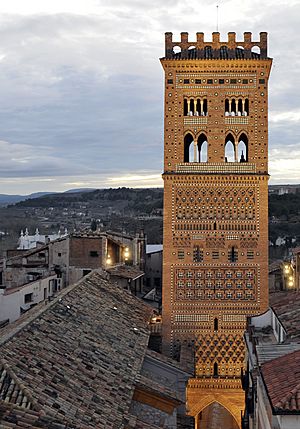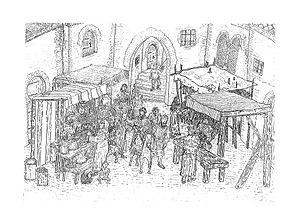Mudéjar facts for kids
Mudéjar refers to Muslims who stayed in Spain and Portugal during the late medieval period. This was after Christian kingdoms had taken back control of the land from Muslim rulers.
The word "Mudéjar" also describes a special style of art and architecture. This art was heavily influenced by Islamic art, but it was often created by Christian artists for Christian buildings.
The term Mudéjar originally meant Muslims from Al-Andalus (the Muslim-ruled parts of Iberia) who remained after the Christian Reconquista. They were not immediately forced to change their religion or leave. The word comes from the Arabic Mudajjan, which means "subjugated" or "tamed." It likely started as a teasing word, like calling someone a "tamed animal." However, it can also mean "one permitted to remain," showing that Christians allowed them to stay.
Muslim writers also used a similar term, ahl al-dajn, meaning "people who stay on." Mudéjars in Iberia had a special "protected" status called dajn. This status meant they were under Christian rule. Their rights were set by local laws called fueros. Some Muslims outside Iberia did not approve of the Mudéjars' choice to live under non-Muslim rule.
The term Mudéjar was different from other groups. It didn't refer to Muslims living in Muslim-ruled areas, like Granada before 1492. It also didn't refer to Moriscos, who were Muslims forced to convert to Christianity. Moriscos might have secretly continued practicing Islam.
The Treaty of Granada in 1491 promised to protect the religious freedom of Muslims. This was when the last Muslim kingdom, the Emirate of Granada, became part of Christian Spain. Unlike Jewish people, who were expelled that same year, Mudéjars kept their protected religious status. However, over the next few years, their religious freedom slowly disappeared. They faced more and more unfair treatment.
By 1497, Islam was made illegal in Portugal. By 1502, it was outlawed in the Crown of Castile, and by 1526, in the Crown of Aragon. This forced Mudéjars to either convert to Christianity or leave the country. After these forced conversions, they were called Moriscos. People often suspected that Moriscos were not truly Christian but secretly practiced Islam. The Moriscos were eventually expelled from Spain between 1609 and 1614.
Mudéjar Life in Spain
Castile
Many Muslim people in Castile originally came from cities like Toledo and Seville. They were not native to the land in Castile. The Christian Kingdom of Castile actually encouraged Muslims to move there. It is thought that the Christian population was growing slowly, so they needed more people.
Old documents from the 13th century show that Muslims in Castile had some freedom under Christian rule. Mudéjars could keep their religion, their own laws, and even had their own judges. They spoke the same Romance languages as their Christian neighbors.
Aragon and Catalonia
Like those in Castile, Mudéjars in Aragon and Catalonia also spoke the local Romance languages. However, in Aragon, and less so in Catalonia, there were Muslim villages that existed before the Christian takeovers. This meant Muslims had a long history of living and farming on that land.
Muslim farmers in Aragon, called exarici, had a special status. They had to farm the land for the Christian king. But this status also meant that their land could be passed down to their Muslim family members. Even though they were later expelled, the Mudéjars in Aragon left behind amazing architecture. In Catalonia, you can see hints of their style in some old churches.
The city of Lleida in Catalonia had a large Muslim quarter, or Morería. This community, called an Aljama, had its own leaders like Islamic scholars and judges. It also had a mosque, baths, a cemetery, a market, and a bakery. Over time, this community became smaller and lost some of its special rights. Eventually, its members were forced to convert or leave during the later expulsions.
Valencia
In the 13th century, Christian rulers from Aragon conquered Valencia. In Valencia, the Mudéjar population was much larger than the Christian population. Most communities were Muslim, spoke Arabic, and were farmers.
Even though a Christian king ruled Valencia, not a Muslim leader, this difference shaped the Mudéjars' lives. There were often riots against Mudéjars in Valencia. Christian rioters frequently attacked Mudéjar communities, even though the king was supposed to protect them. Violence against Mudéjars was common in this region.
See also
 In Spanish: Mudéjar para niños
In Spanish: Mudéjar para niños
Sources



